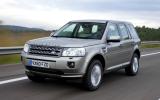What is it?
This is the new two-wheel drive Land Rover Freelander eD4. Under pressure to meet the demand for cleaner, Euro-5 compliant cars, the famous 4x4 marque has had to think the unthinkable and develop a two-wheel drive powertrain for its compact SUV.
Despite Land Rover’s all-wheel drive heritage it’s important for Land Rover to compete in the ever-increasing two-wheel drive SUV market. So, with no heavy AWD system and an improved stop-start and more efficient 2.2-litre engine the new eD4 manages to gets its CO2 figure down to a respectable 158g/km and 47.2mpg.
See the test pics of the Land Rover Freelander eD4
What’s it like?
The big question for fans of the marque is does it still merit a Land Rover badge (which incidentally is now circled in silver rather than gold) on the front? At the Land Rover Experience off-road driving course at Les Comes, Barcelona, I drove both this new front-wheel drive Freelander back to back with the latest 187bhp SD4 HSE auto all-wheel drive model.
This is the top-spec car (beneath this model sit the less powerful TD4 and eD4) and equipped with its Terrain Response and Hill Descent Control tackled terrain such as rocky and uneven tracks, steep inclines, ruts, ditches, extreme ascents and descents with aplomb, as you would expect from one of the most capable 4x4s on the market.
Then it was time to hit the rough stuff in the most fuel-efficient car that Land Rover has ever made. Admittedly the 2WD SUV needed much more coaxing, and occasionally it lost traction, but the lighter car still has an abundant 310lb ft (15lb ft more than the outgoing model) of torque, all of which helped the front-wheel drive car even plough through the water obstacle without missing a beat. The eD4 is still very much a Land Rover and has the same underbody protection, sump guard and great ground clearance as the 4WD model.
Of course, for the vast majority of buyers in the compact SUV market, such information is of little interest, as few cars ever make it that far off tarmac. Of more importance will be that the new eD4 manages 47.2mpg and only emits 158g/km of CO2.
The Freelander’s improved stop-start system helps contribute to this figure, and thanks to a bi-directional crank sensor and trigger wheel the system is able to establish the crankshaft position quicker, helping the car’s engine fire-up with 30 per cent better efficiency.
On the outside changes to the 2011 are pretty subtle. A new front bumper assembly gives the car a more planted look, and there’s a new front grille, too, which is available in either a dark or light finish. Headlamps are improved while the rear lights have a clear inner lens.
Inside not much has changed, there’s some new fascia finishes which help improve the cabin’s premium feel, but there’s still an expanse of hard plastics and much of the switchgear has a utilitarian feel to it.
On the road, the new engine’s Improved economy hasn’t affected performance, though, as the entry-level engine’s 0-60mph time remains at 10.9 seconds and on our short test drive the front-drive car handled and rode well on the Spanish roads. Steering was accurate and well balanced, but it still feels noisy at motorway speeds and its grip doesn’t seem diminished by only having front-wheel power; at lower speeds the 2WD seemed quicker to turn in.



























Join the debate
Add your comment
Re: Land Rover Freelander eD4
So? As many have pointed out already, that doesn't matter. At most it'll carry 2.4 kids and a dozen bags of shopping across a wet Tesco's car park.... This will make money for LR, to hopefully spend on making proper 4x4, just as Porsche do the other way round (The Cayenne supporting the 911).
Re: Land Rover Freelander eD4
I would expect it to perform similarly off road to an old Renault, with good ground clearance, long suspension travel and reasonably high profile tyres. that is significantly better than almost all current front wheen drive cars.
Assuming that I am correct than it seems a fair write up, except for failing to point out it may not tow a trailer across a wet field.
Re: Land Rover Freelander eD4